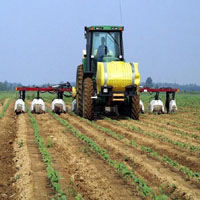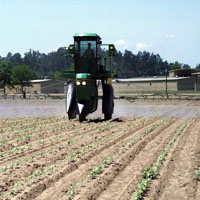Can you tell me about sprayer calibration?
1. For a broadcast boom - measure the distance between nozzles. Measure it, don't guess. For a band, either on a planter or on a cultivator, measure the width of the area sprayed (band).
 2. Determine the length, in feet, of a 1/128 acre plot for the measured nozzle spacing or band width. This will be the distance to time the tractor.
2. Determine the length, in feet, of a 1/128 acre plot for the measured nozzle spacing or band width. This will be the distance to time the tractor.
3. To do this use the following formula: 43,560 (square feet per acre) / divided by nozzle spacing or band width in feet / divided by 128. * Example - 19 inch band on a cultivator 19 / 12 = 1.583333 feet (band width in feet) 43,560 (sq.ft./ac) / 1.583333 = 27511.584 27511.584 / 128 (ounces in a gallon) = 214.934 (215) feet to time the tractor.
4. Determine the time in seconds for the tractor to travel 215 feet. (Remember to determine the time to travel the distance under the condition of operation, i.e. with the cultivator down, etc.)
 5. With the pressure set and the sprayer spraying, catch water from all tips spraying the band (or one tip on a broadcast boom) for the exact same time it took to travel the prescribed distance and measure it in ounces. * Lets say it took 25 seconds and you caught 10 ounces. You are putting out 10 gallons of volume per treated acre.
5. With the pressure set and the sprayer spraying, catch water from all tips spraying the band (or one tip on a broadcast boom) for the exact same time it took to travel the prescribed distance and measure it in ounces. * Lets say it took 25 seconds and you caught 10 ounces. You are putting out 10 gallons of volume per treated acre.
6. Determine the tank capacity and divide by the volume per treated acre. * Example: 300 gallon tank capacity and 10 gallons per treated acre = 30 acre per tank load. This tells you that the sprayer will treat 30 acres. Don't worry about how many acres the tractor will drive over - it will treat 30 acres.
7. Determine the broadcast rate of the product, or products in question and add enough to the tank to treat 30 acres on a broadcast basis. The tractor will treat 30 treated acres and don't worry how many planted acres it runs over.
Publications
News
STARKVILLE, Miss. -- Expect to see significantly less cotton than usual blooming in Mississippi later this year.
STARKVILLE, Miss. -- Row crop producers who reported financial loss in 2024 may be eligible for economic assistance through a U.S. Department of Agriculture resource.
STARKVILLE, Miss. -- Row crop growers in Mississippi expect to plant more corn in 2025 than they did last year, but not as much cotton or as many soybeans.




